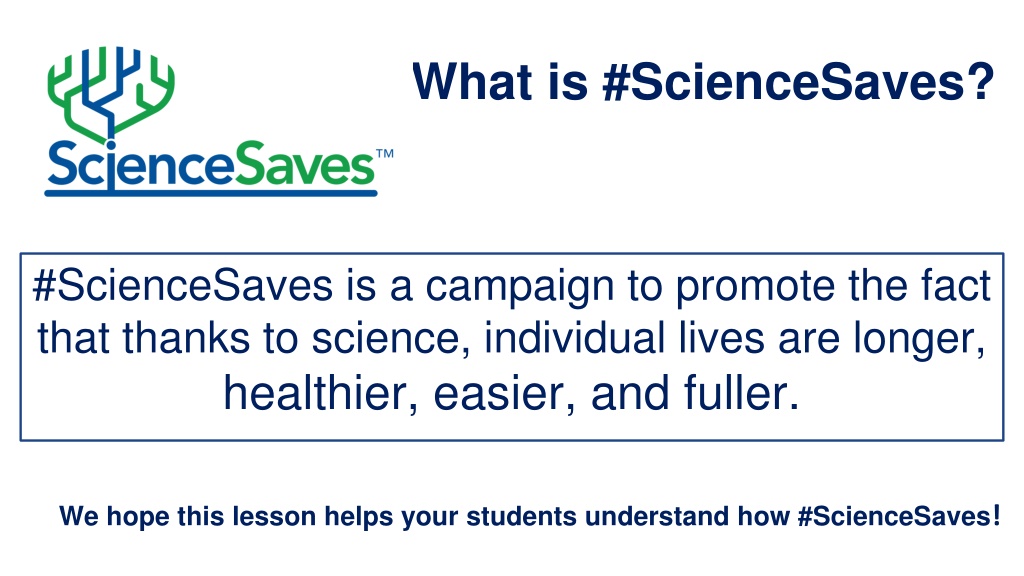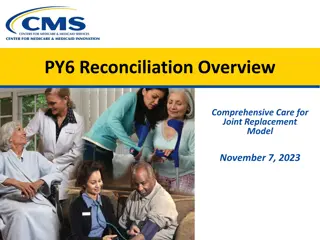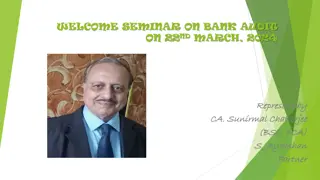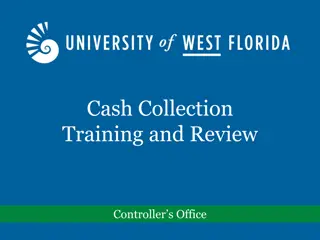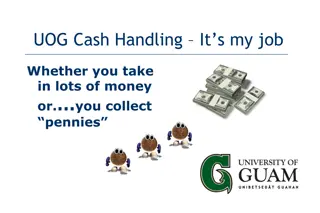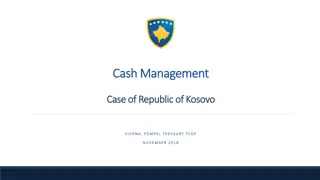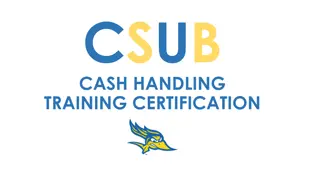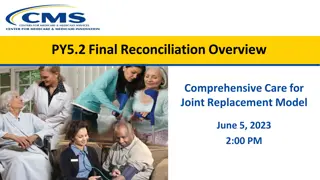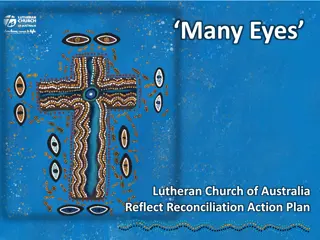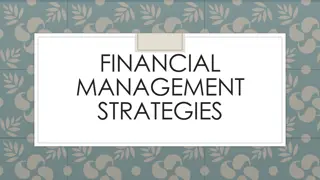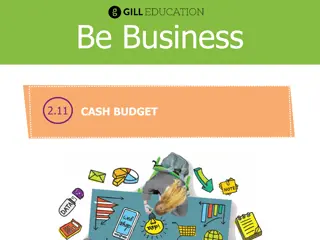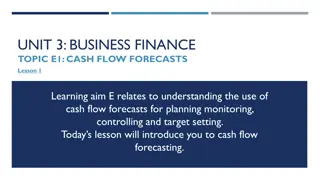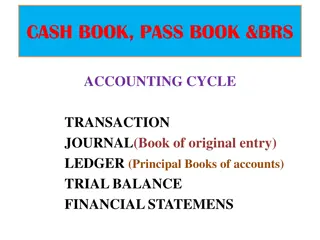Internal Cash Reconciliation Insights
Gain valuable insights into managing internal cash reconciliation efficiently with tips on identifying, addressing, and preventing balance discrepancies. Explore the use cases, monitoring queries, and resolution strategies for maintaining accurate financial records.
Download Presentation

Please find below an Image/Link to download the presentation.
The content on the website is provided AS IS for your information and personal use only. It may not be sold, licensed, or shared on other websites without obtaining consent from the author.If you encounter any issues during the download, it is possible that the publisher has removed the file from their server.
You are allowed to download the files provided on this website for personal or commercial use, subject to the condition that they are used lawfully. All files are the property of their respective owners.
The content on the website is provided AS IS for your information and personal use only. It may not be sold, licensed, or shared on other websites without obtaining consent from the author.
E N D
Presentation Transcript
What is #ScienceSaves? #ScienceSaves is a campaign to promote the fact that thanks to science, individual lives are longer, healthier, easier, and fuller. We hope this lesson helps your students understand how #ScienceSaves!
#ScienceSaves How can poetry help communicate scientific ideas and innovations? Grades 6-8 https://thepoetryofscience.scienceblog.com/2 174/majestic-migration/
Before we begin: Think-Pair-Share Think about the following questions. Share your thoughts with the person next to you. Then, if you d like, share with the class. 1. What are your experiences with poetry? 2. What are scientific innovations? 3. How can poetry help communicate scientific ideas and innovations?
In this lesson, you will create a poem from informational text. Ask yourself: Where can you find poetry embedded within informational text? Directions to create a found poem: 1. You will read two articles. You will create a poem using ONE of the two articles. (Click on the article title to be taken to a digital version). "How to Protect Birds and Bats from Wind Turbines" by Chris Baranuik (BBC) "Bird-Friendly Building Design" by New York Audubon and American Bird Conservancy 2. Carefully re-read your selection several times. 3. Highlight or underline the words and short phrases that you find particularly powerful, moving, or interesting. Think: What tone do these words convey? In your poem, you will need to convey that same tone about the topic. Will there be a shift in tone? 4. Meet with a classmate. Explain: Why did you choose those words and phrases? Did you classmate choose the same? Why or why not? 5. Write the words and phrases that you highlighted in a list. Leave space after each word or phrase so it it s easier to choose the ones you want for your poem.
Directions (Continued) to create a found poem: 6. Re-read the words and phrases on the list. Are there any words that have similarities? Categorize them. What categories could you include? Imagery taste, smell, see, hear, or feel Connotative meanings Parts of speech Phonics 7. Create your poem. You may need to go back to your selection to add more words to your list. Make any minor changes necessary to revise your poem. You can change punctuation, tenses, possessives, plurals, and/or capitalization. Think about sound devices such as, rhyme, repetition, alliteration, assonance, and consonance. How will they affect the theme of your poem? How could you use them to emphasize parts of your poem so that the theme the conveyed? 8. Think about the POWER of PUNCTUATION in free verse poetry. Where would you like your readers to pause? Why? Be sure to place a comma or period there depending upon the length of the pause. How might you use dashes or colons? What functions will they serve in your poem? How will you use enjambments? (In verse, the continuation without a pause at the end of a line or stanza) Which lines will you end with punctuation? How will you use caesurae (a pause in the middle of a line) initial, medial, and terminal?
Directions (Continued) to create a found poem: 9. How will you organize the lines and stanzas? How will your choices contribute to the tone of the poem? How will it emphasize the words and phrases that contribute to the tone? Re-read your poem several times. If you absolutely need to add a word or two to make your poem flow more easily, you may add up to two of your own words, but no more than two. 10. Title your poem. Think about the subject of your poem. Will you want to reference the subject in the title? 11. Citation: At the bottom of your poem, tell where the words came from. Example: Time to Eat by (student author s name), based on Chang-rae Lee s essay, Coming Home, Again. 12. Meet with a classmate. Ask them to complete the peer review form. Remember to submit it with the final draft of your poem.
Found Poem Peer Review Form Questions Evaluator s responses with evidence Is the subject of the article accurately portrayed in the found poem? Why or why not? Has the poet demonstrated careful word choice? Why or why not? Found Poem Peer Review Form Poet: ___________________________ Evaluator: ________________________ Directions: 1. What article did the poet choose? Review it. 2. Read the poem. 3. Complete the chart. 4. Discuss your evaluation with the poet. Write a one-two sentence summary of your peer review conference. _______________________________________ _______________________________________ _______________________________________ _______________________________________ _______________________________________ _______________ What is the tone of the poem? How can you tell? Is there a shift in tone? Has the poet used sound devices with intention? Explain. What types of punctuation are used? How do they contribute to emphasis? Has the title been carefully chosen? Why or why not?
Example found poem from Coming Home Again by Chang-rae Lee From that day, my mother prepared a certain meal to welcome me home. It was always the same. Even as I rode the school s shuttle bus from Exeter to Logan airport, I could already see the exact arrangement of my mother s table. I knew that we would eat in the kitchen, the table brimming with plates. There was the kalbi, of course, broiled or grilled depending on the season. Leaf lettuce, to wrap the meat with. Bowls of garlicky clam broth with miso and tofu and fresh spinach. Shavings of cod dusted in flour and then dipped in egg wash and fried. Glass noodles with onions and shiitake. Scallion- and-hot-pepper pancakes. Chilled steamed shrimp. Seasoned salads of bean sprouts, spinach, and white radish. Crispy squares of seaweed. Steamed rice with barley and red beans. Homemade kimchi. It was all there the old flavors I knew, the beautiful salt, the sweet, the excellent taste. I wish I had paid more attention. After her death, when my father and I were the only ones left in the house, drifting through the rooms like ghosts. I sometimes tried to make that meal for him. Though it was too much for two, I made each dish anyway, taking as much care as I could. But nothing turned out quite right not the color, not the smell. At the table neither of us said much of anything. And we had to eat the food for days. Time to Eat My mother prepared A certain meal To welcome me home. We would eat in the kitchen Table brimming Kalbi and kimchi leaf lettuce, glass noodles, garlicy clam broth with miso and tofu Shavings of cod, shitake, shrimp Sprouts, spinach, seaweed, scallion and pepper pancakes steamed shrimp, steamed rice The old flavors I knew Beautiful, salt, sweet, excellent. I wish I had paid more attention. Time to Eat by (student author s name), based on Chang-rae Lee s essay, Coming Home, Again.
Teacher Notes: Bird Migration and Found Poetry Suggested Timeline Day 1/90 minutes Introduce lesson, read article, highlight words for the found poem Day 2/90 minutes Review article and highlighted words, meet with classmate to discuss list, categorize words Day 3/90 minutes Use list to create first draft of poem, title the found poem, cite the article, peer review Day 4/90 minutes Revisions based on peer review, publish final draft
Element Points Earned, 0-5 Through word choice, the student has demonstrated a clear understanding of the content within the article. Effective use of poetic elements such as imagery and sound devices are found throughout the poem. Caesurae and enjambments are used with intention and for emphasis. Student has included 20-30 lines and shown careful consideration for line lengths and stanzas Found Poem Rubric
Reading Informational Text: Craft and Structure CCSS.ELA-LITERACY.RI.6.4 Determine the meaning of words and phrases as they are used in a text, including figurative, connotative, and technical meanings. CCSS.ELA-LITERACY.RI.6.5 Analyze how a particular sentence, paragraph, chapter, or section fits into the overall structure of a text and contributes to the development of the ideas. CCSS.ELA-LITERACY.RI.6.6 Determine an author's point of view or purpose in a text and explain how it is conveyed in the text. CCSS.ELA-LITERACY.RI.7.4 Determine the meaning of words and phrases as they are used in a text, including figurative, connotative, and technical meanings; analyze the impact of a specific word choice on meaning and tone. CCSS.ELA-LITERACY.RI.7.5 Analyze the structure an author uses to organize a text, including how the major sections contribute to the whole and to the development of the ideas. CCSS.ELA-LITERACY.RI.7.6 Determine an author's point of view or purpose in a text and analyze how the author distinguishes his or her position from that of others. CCSS.ELA-LITERACY.RI.8.4 Determine the meaning of words and phrases as they are used in a text, including figurative, connotative, and technical meanings; analyze the impact of specific word choices on meaning and tone, including analogies or allusions to other texts. CCSS.ELA-LITERACY.RI.8.5 Analyze in detail the structure of a specific paragraph in a text, including the role of particular sentences in developing and refining a key concept. CCSS.ELA-LITERACY.RI.8.6 Determine an author's point of view or purpose in a text and analyze how the author acknowledges and responds to conflicting evidence or viewpoints. National ELA Standards, 6th-8th Grade
Production and Distribution of Writing CCSS.ELA-LITERACY.W.6.4-8.4 Produce clear and coherent writing in which the development, organization, and style are appropriate to task, purpose, and audience. National ELA Standards, 6th -8thGrade CCSS.ELA-LITERACY.W.6.5-8.5 With some guidance and support from peers and adults, develop and strengthen writing as needed by planning, revising, editing, rewriting, or trying a new approach, focusing on how well purpose and audience have been addressed. Language, Vocabulary Acquisition and Use CCSS.ELA-LITERACY.L.6.5.C-8.5.C Distinguish among the connotations (associations) of words with similar denotations CCSS.ELA-LITERACY.L.6.6-8.6 Acquire and use accurately grade-appropriate general academic and domain- specific words and phrases; gather vocabulary knowledge when considering a word or phrase important to comprehension or expression. Speaking and Listening, Comprehension and Collaboration CCSS.ELA-LITERACY.SL.6.1-8.1 Engage effectively in a range of collaborative discussions (one-on-one, in groups, and teacher-led) with diverse partners on grade 6/7/8 topics, texts, and issues, building on others' ideas and expressing their own clearly.
This lesson was brought to you by ScienceSaves. The #ScienceSaves campaign demonstrates how science has benefited human progress and how it offers humanity the tools to address today s most pressing challenges.
